Florida shelter challenges what’s possible and turns the tide for pets

A couple of years ago, the staff at Santa Rosa County Animal Services (SRCAS) began taking big steps forward to reach no-kill. Shelter director Dora Thomason says they worked hard to remove a breed ban that had been in place for years, and they were building strong partnerships with rescue groups and other agencies in the area. But despite the changes, the shelter’s save rate remained low, and the facility lacked the resources needed to help its most vulnerable cats and dogs, including neonatal kittens and dogs with behavioral challenges.
Dora, along with Brad Baker, director of public safety for Santa Rosa County, started looking for solutions, determined to change the tide for every pet in their Florida community. But the more they looked for solutions, the more they came up empty. “I was tired of reading research papers,” says Brad. “What we needed were partners who would get in the game and help us change.”
A Best Friends staff person encouraged Brad and Dora to attend the Best Friends National Conference in Dallas, and that’s where they learned about the Maddie’s® Shelter Embed Project (#ThankstoMaddie). Through generous support through Maddie’s Fund®, this initiative aims to help shelters with great need adopt a community-based sheltering approach (with the help of Best Friends staffers, who roll up their sleeves and work alongside shelter staff to help improve operations), implement lifesaving programs and help any other areas where there’s a need.
Finally, SRCAS had found the partnership they’d been looking for. When Michelle Logan, Best Friends director of national embed programming, visited the shelter, she knew the embed project could take the facility’s lifesaving efforts to the next level. “From the first day, I could see how eager they were to save more animals and how frustrated they were with having people tell them how to do it, but not meeting them where they were at and showing them how,” says Michelle.
Not long after that, Jessica Gutmann arrived at SRCAS as the Best Friends embed operations manager, more than ready to get in the game. It wasn’t going to be easy, though. To help them get closer to their goal of becoming no-kill, Jessica would have to help the staff make some pretty significant changes. Change can be difficult to embrace, and Jessica learned quickly that if she was going to help the staff get on board with new programs (during a pandemic, no less), she would first have to earn their trust.
[One amazing gift: Maddie’s Fund donates $1.5 million to help save up to 12,000 dogs and cats]
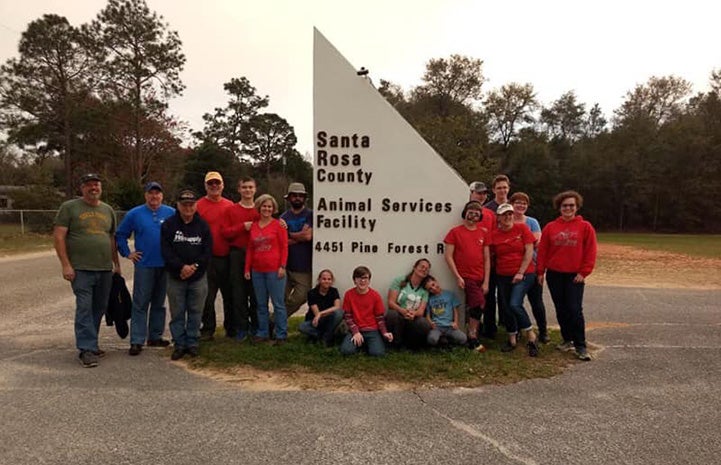
Helping the tiniest kittens in the shelter
While Santa Rosa County does have a kitten season, the climate in the area is warm enough that kittens are born outdoors year-round, and many of them end up at the shelter. But shelters are not ideal for kittens, whose immune systems are still developing. Without the resources to help them, their young lives were often at risk as soon as they arrived at SRCAS.
“Despite our efforts, we were still having to euthanize kittens (too young to eat on their own) because we just couldn’t save them all,” says Jennifer Arn, the shelter’s foster coordinator. “One huge problem was people dumping litter after litter at the shelter when we were already at full capacity. Our staff was exhausted and burned out.”
Jennifer was hopeful when Jessica came on board. But when Jessica announced that the new plan was to place all kittens in foster homes within 24 hours after arriving at the shelter (at one of her first staff meetings, no less) Jennifer had a hard time getting on board. “My mouth dropped as the thoughts in my head circled,” Jennifer says. “What came out of my mouth was: ‘That just isn’t possible.’”
“It is,” was Jessica’s response. And with that, Jennifer and her team resolved to implement the plan to find foster homes as quickly as the kittens came in. And they did. Although the plan was working, Jennifer vividly remembers the day when 19 kittens showed up at the end of the day and she reached a breaking point. “I felt defeated,” she says, “but the director, shelter vet, a few staff members and I divided them up for the night and the next morning, I was able to get them to other foster homes.”
[South Texas shelter demonstrates what’s possible in the drive to achieve no-kill nationwide by 2025]
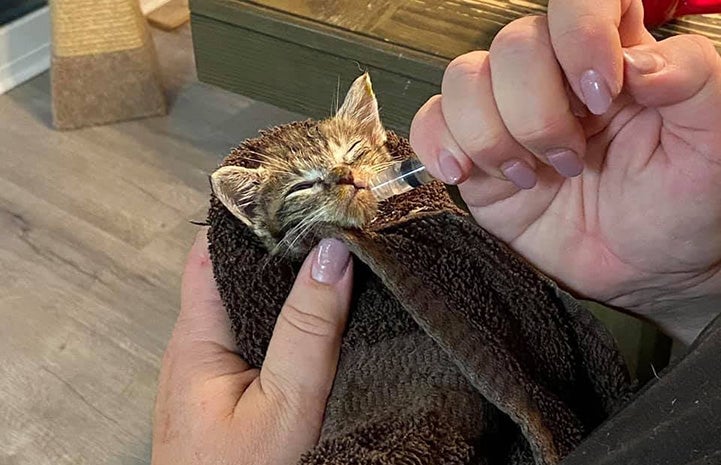
A focus on community cats
At the start of Jessica’s tenure at SRCAS, cats at the shelter were losing their lives at a higher rate than dogs, so one of the first things she did was to implement a community cat program, including shelter-neuter-return (SNR). Under the program, healthy cats coming to the shelter as “strays” would be spayed or neutered, vaccinated and returned to where they were found. Up until then, cats coming into the shelter as strays had little chance of leaving the shelter alive unless a rescue group was able to take them.
Luckily, the law was on their side because Santa Rosa County had just passed an ordinance allowing free-roaming cats to be placed back in the community. So, when the embed project got underway, the shelter finally had the tools to launch its inaugural community cat program ― almost.
There was still one big obstacle in the way: The shelter didn’t have the ability to perform spay/neuter surgeries on-site, and while some veterinarians in Santa Rosa were willing to work with the shelter to spay or neuter pets at a reduced rate, there was a limit to the time and resources they could spare.
In order for the community cat program to be successful, the shelter would need an area for Dr. Megan Arevello, the SRCAS veterinarian who was also instrumental in moving the community cat program forward, to perform spay/neuter surgeries. This would also help dogs and adoptable cats entering the shelter have their required spay/neuter surgeries and get adopted faster.
After securing funding from Best Friends for surgical equipment, Jessica and the team cleared out a supply closet and set up a temporary spay/neuter suite.
Still, everyone at the shelter wasn’t immediately on board with the community cat program, including Audra Mullins, a SRCAS animal control officer who pushed back hard. But once she saw the save rate climb and cats continue to flourish outdoors after being spayed or neutered and released back where they were found, she changed her thinking.
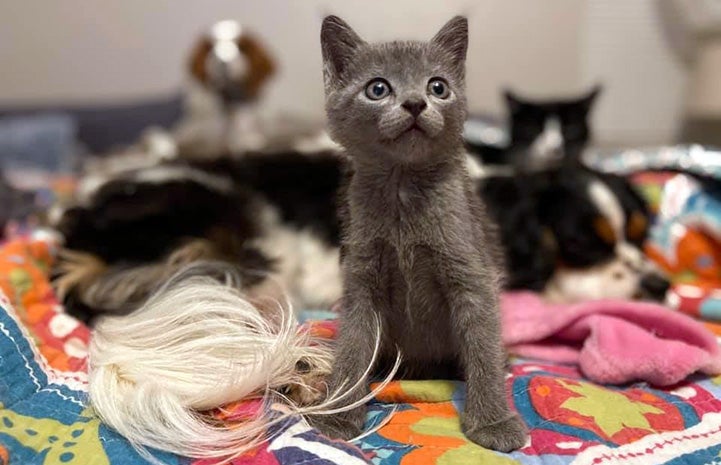
Letting every dog have the limelight
When Jessica first came on board, she noticed that the shelter tended to promote the dogs easiest to adopt more often than those with behavior challenges or other quirks.
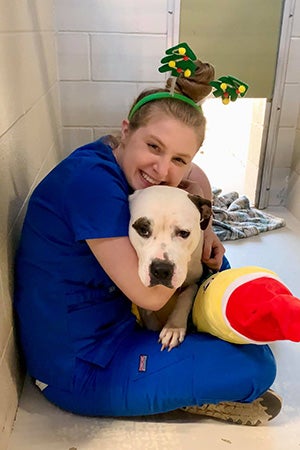 For some of these dogs, kennel life was particularly difficult, and they showed it by barking, jumping and exhibiting other behaviors that looked scarier than they were. Not only did this deter potential adopters, but it was challenging for staff, too. Understandably, some shelter staff members were not comfortable getting close to dogs whose behavior they perceived as threatening. But the longer the dogs stayed at the shelter, the more anxious or sad they were apt to become. And that meant they were at a greater risk of not being adopted.
For some of these dogs, kennel life was particularly difficult, and they showed it by barking, jumping and exhibiting other behaviors that looked scarier than they were. Not only did this deter potential adopters, but it was challenging for staff, too. Understandably, some shelter staff members were not comfortable getting close to dogs whose behavior they perceived as threatening. But the longer the dogs stayed at the shelter, the more anxious or sad they were apt to become. And that meant they were at a greater risk of not being adopted.
The key was to train staffers to feel safe enough to give these dogs the time and attention needed to feel better and show it, so they could finally get adopted.
Best Friends staff members contacted Jen Deane, a certified dog trainer, who came to the shelter for three days and worked with the SRCAS team so they could learn more about dog body language, enrichment and practical ways to improve their skill sets.
People from Dogs Playing for Life also visited the shelter and taught the staff how to run play groups. Jessica says this helped dogs immensely by “simply giving them an outlet for their energy and the ability to express normal dog behaviors.”
The changes marked a huge turning point for both the staff and the dogs needing the most help. Armed with newfound confidence while working with behavior-challenged dogs, the staff was able to help them stay off the euthanasia list and get to where they were always meant to be: home.
[Three cheers for three outstanding animal shelters]
It took a village: clearing the shelter during a pandemic
The core of the embed project is helping shelters make the shift to community-centered sheltering, an approach that proved invaluable for SRCAS when the coronavirus pandemic got underway. It was a time when they needed help from the Santa Rosa community more than ever.
Talk about timing: Jessica had only been at SRCAS for about a month last spring when the shelter closed temporarily. But instead of viewing the challenge as insurmountable, she and the SRCAS team saw it as an opportunity to give the community a seat at the table as partners in lifesaving. If the shelter was going to help pets during the pandemic and eventually reach the goal of becoming no-kill, the community would play a vital role in making it happen.
Together, Jessica and Jennifer devised a plan to find foster homes for all pets at the shelter by tapping into the power of social media to drum up community support more than they ever had before. Their plan worked and, for the first time ever (during a global pandemic, no less), they cleared the shelter.
The feat was so remarkable that it made headlines in the Pensacola News Journal. But when readers saw the photo of a beaming SRACS staff standing outside empty kennels, they weren’t just looking at a group of dedicated, happily exhausted employees refusing to stop until every pet was in a foster home or adopted. They were also looking at a photo of a shelter that had just rewritten its story.
From that day forward, the community started to view the shelter as a valuable resource, rather than a depressing old school “pound” where pets who went there didn’t always get a chance to leave.
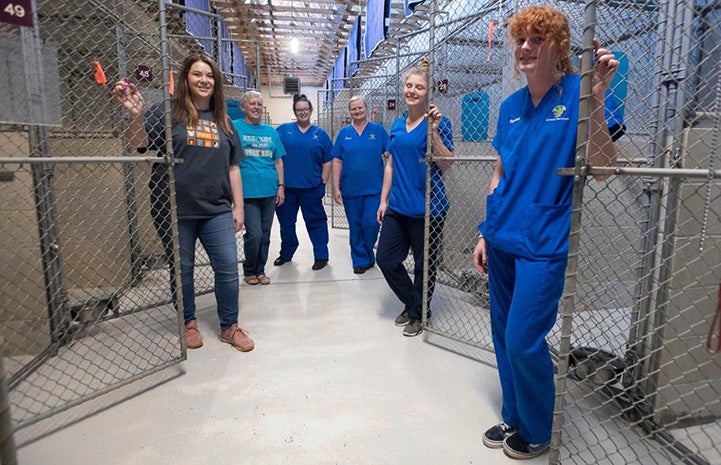
A new day for pets in Santa Rosa County
 Today things at SRCAS look different than they did when Jessica first touched down in Florida wide-eyed and ready to start her new role as the shelter’s embed operations manager.
Today things at SRCAS look different than they did when Jessica first touched down in Florida wide-eyed and ready to start her new role as the shelter’s embed operations manager.
These days you’re apt to find SRCAS animal control officers (ACOs) in the community helping any way they can to keep pets out of the shelter ― from delivering food to pet families in need to placing to placing “found dog” signs with the shelter’s contact information in the area where each dog is picked up. ACOs can now scan for a microchip whenever they find a dog and they check Facebook lost-and-found groups before bringing the dog to the shelter. And remember Audra Mullins, the ACO who at first was skeptical about the community cat program? She’s now the community cat program lead.
During the embed project, Best Friends helped the shelter hold a fundraiser to purchase portals for cat kennels, making it possible for cats to use two adjacent enclosures so they have more room to stretch their legs. It all goes into making them feel more comfortable at the shelter, which in turn, helps them get adopted.
Jessica also worked with the shelter to grow the volunteer program by taking the lead in switching the shelter’s software to ShelterLuv, which helps to accurately track its progress and save the county more than $10,000 a year.
Jessica has also helped the shelter embrace change and find confidence. “There were uncomfortable transitions, lots of working toward resolutions, and a big melting pot of ideas where people did not always agree,” says Jennifer. “But at the end of the year, we surpassed goals, strengthened our foundation and were able to do so with a save rate that is considered no-kill. If we can do it, anyone can.”
Giving a shelter staff the confidence to save lives
 Jessica, who’s back in Utah, says there’s not a day that goes by when she doesn’t think back on her time in Santa Rosa. There were days early on when she’d leave the shelter in tears because the pushback from some on the staff was too much to bear. But by the time her tenure came to a close, she found it hard to say goodbye.
Jessica, who’s back in Utah, says there’s not a day that goes by when she doesn’t think back on her time in Santa Rosa. There were days early on when she’d leave the shelter in tears because the pushback from some on the staff was too much to bear. But by the time her tenure came to a close, she found it hard to say goodbye.
“When they started to see results, that’s when they gradually began opening up to more possibilities and embracing them,” says Jessica. “Eventually, I think the staff looked back and realized it’s better to spend your days helping to save animals than be in the euthanasia room.”
Of course, if Jessica ever doubted the impact of the embed project on the shelter, all she has to do is think of SRCAS’s soaring save rate that reached 97% in January or read the letter she received from the staff on her final day.
“Not only have our attitudes about the shelter changed, but so have our values and beliefs,” the letter says. “You helped us believe this transformation was possible and walked us through each step of the way. What would have taken years to change, you made happen in months. You brought us the strong will we needed and never stopped pushing us to improve.”
Help pets where you live
Be a part of the change by volunteering to help pets at shelters in your community
Read more
5 acts of kindness from everyday heroes
Volunteers tech-savvy skills help pets during pandemic
Caregiver finds second chance for his cherished community cat
Photos courtesy of Santa Rosa County Animal Services Shelter